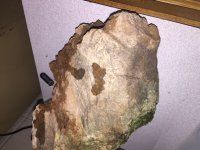jr.nation88
Jr. Member
- Jan 14, 2012
- 27
- 4
- Primary Interest:
- Other
Our ecology class is looking at restoring a natural glade behind our school. In order to do so, the ecology teacher told them that they first needed to identify the type of rock that primarily makes up the hill side. So, because I teach science, they figured I would be able to do it quickly but that has not been the case.
From first glance I thought dolomite but it did not pass the acid reactivity test. Even after scraping the gunk off I got no effervescence of any sort so I figured that ruled out limestone/dolomite. It seems to have a little quartz sprinkled throughout which made me thing maybe chert that maybe had morphed but i'm stumped.
Any thoughts from those of you who know more than me? Located in SE Missouri in the hill country
From first glance I thought dolomite but it did not pass the acid reactivity test. Even after scraping the gunk off I got no effervescence of any sort so I figured that ruled out limestone/dolomite. It seems to have a little quartz sprinkled throughout which made me thing maybe chert that maybe had morphed but i'm stumped.
Any thoughts from those of you who know more than me? Located in SE Missouri in the hill country










